Scapolite Gemstone: Properties, Meanings, Value & More
 “Scapolite” (skap·uh·lite) is a term commonly used to describe a single gem type. However, the name more accurately refers to an aluminosilicate series of minerals that includes meionite, marialite, and silvialite.
“Scapolite” (skap·uh·lite) is a term commonly used to describe a single gem type. However, the name more accurately refers to an aluminosilicate series of minerals that includes meionite, marialite, and silvialite.
Scapolite gemstones are often shades of honey-yellow but can present in other colors. In fact, they’re often confused with other gems like alexandrite, amethyst, citrine, and golden beryl — among others!
Is scapolite a rare stone? Yes! Scapolite stone is an extremely rare and sought-after semi-precious gemstone! However, some gems lack the durability and hardness for most mainstream jewelry use. Instead, it’s classified as a collector’s stone.
Don’t worry though, you’ll still be able to snag some scapolite jewelry!
On that note, let’s dig a little deeper as we teach you all there is to know about this unique, metamorphic mineral!

What is Scapolite Stone?
Scapolite was once dubbed "wernerite." Nowadays, the name “wernerite” has mostly disappeared from use. Other names include mizzoni, dipyre, marialite, and meionite.
Scapolite vibrates to the number 1 in numerology. It’s also believed to be a lucky, lesser-known zodiac stone for Taurus and Libra.
This mineral is popular in interior design. Scapolite quartz countertops are durable, low maintenance, and pretty! Does that mean scapolite is a quartz? Nope! Scapolite and quartz can be tricky to differentiate. One way to tell is by assessing their hardness! Quartz, being a strong 7 on the Mohs scale, is harder and capable of scratching scapolite.
So what does scapolite look like?
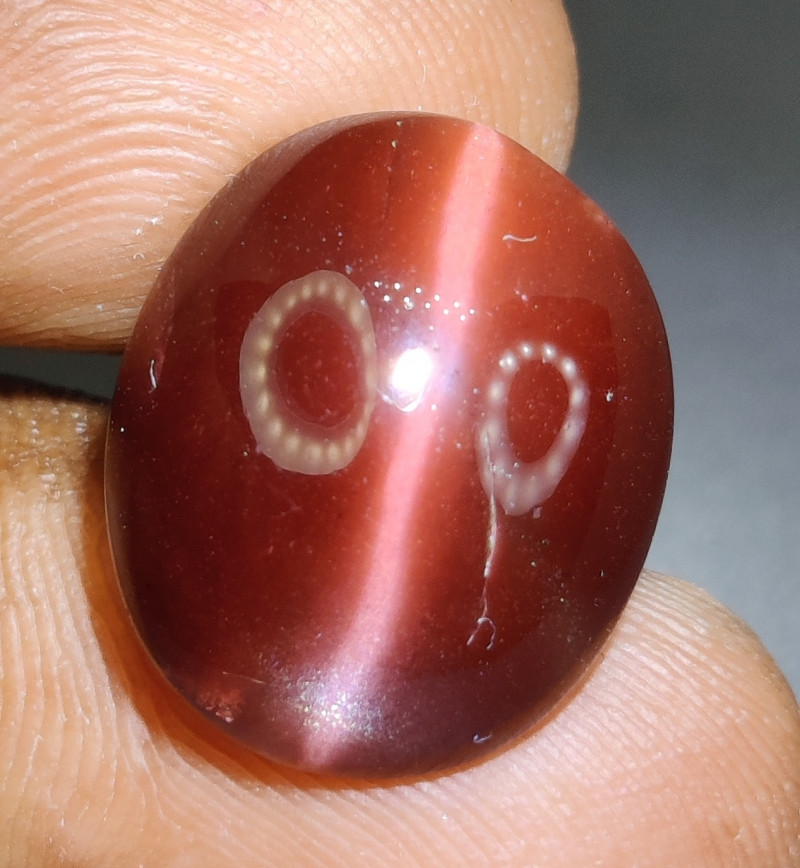
Scapolite Specifications & Characteristics
Scapolite is a versatile gem!
What color is scapolite besides yellow? It can be colorless to variations of any hue imaginable. One variety has been called "pink moonstone” because it shows a similar sheen similar to the feldspar gem.
Scapolite color variations reflect disparities in composition, which range from calcium-rich to sodium-rich. Because of perfect prismatic cleavage, it’s considered to have a fair toughness.
Scapolite hardness ranges between 5 and 6 on the Mohs mineral hardness scale, which is too soft to serve as a scapolite ring stone without a protective setting. Hence, its classification as a collector's stone. It may not be as popular for jewelry as other gems, but it can still be mounted in earrings or pendants with lower risks of impact or abrasion.
Here’s an overview of scapolite properties:
Chemical Formula: (Na,Ca)4[Al3Si9O24]Cl
Mineral Family: Scapolite Group
Composition: Silicate
Mohs hardness: 5.5 - 6
Color: Colorless, white, blueish gray, pale greenish-yellow, pink, violet, brown, orangey-brown, golden yellow, orangey-yellow
Crystal structure: Tetragonal, columnar
Luster: Vitreous (glassy); resinous; pearly on cleavages.
Transparency: Transparent to Opaque
Refractive index: 1.540 - 1.579
Density: 2.56 - 2.77
Cleavage: Perfect/distinct in two directions
Fracture: Uneven to Conchoidal
Streak: White
Luminescence: Fluorescent; Violet red in LW-UV, Orange-red in MW, Red in SW
Pleochroism: Pink and violet gems: dark blue/lavender blue; colorless/violet. Colorless and pale yellow stones: colorless to pale yellow/yellow.
Now that we know its mineral characteristics, what does scapolite crystal do?
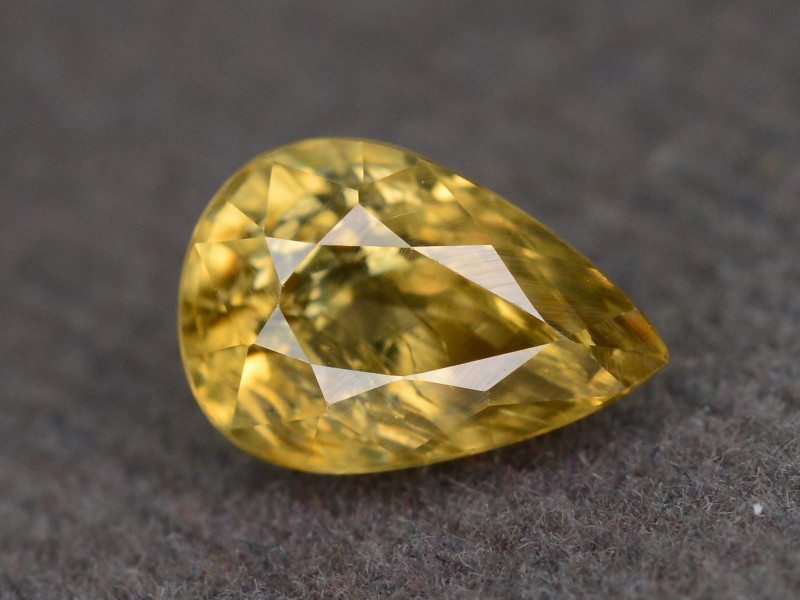
Scapolite Meaning & History
German mineralogist Abraham Gottlob Werner first discovered scapolite in Northern Burma (present-day Myanmar) in 1913. The first specimens were fibrous white, pink, and violet. In 1920, yellow to golden gems were discovered in Madagascar and ten years later in Brazil.
These discoveries were followed by more in Kenya and Tanzania. A purple variety of scapolite called petschite was also discovered in Tanzania in 1975.
In the 18th century, Brazilian scientist José Bonifácio de Andrada e Silva originally named scapolite “wernerite” to honor Abraham Gottlob Werner discovery. Werner has also been called the “Father of German Geology.”
Scapolite’s name derives from the Greek word, ‘skapos, meaning “rod” and lithos for “stone,” due to its long column-like prismatic crystals.
While we’re on the topic of names, let’s touch on how some of scapolite’s other pseudonyms originated:
Marialite came from G. Vom Rath, another German mineralogist. He coined it in honor of his late wife, Maria Rosa.
Meionite is derived from the Greek word, meion meaning “less” because the pyramidal shape of scapolite is smaller than the similar-looking vesuvianite.
Mizzonite is derived from the Greek word, meizon meaning “greater” because the axial ratio of scapolite is greater than that of meionite.
So what is the meaning of scapolite? As an obscure crystal, it lacks the legend and mythology that many of the more popular gems tend to have. However, its strong energy and versatile beauty compensate for its shortage of lore!
In fact, master lapidarist Buzz Gray and jewelry designer Bernadine Johnston created a series of scapolite crystal butterfly brooches. This series, currently shown in LA's Natural History Museum, contains a butterfly called the "Ninja" which features purple Tanzanian scapolite gemstones.
Next, let’s dive into scapolite metaphysical properties!
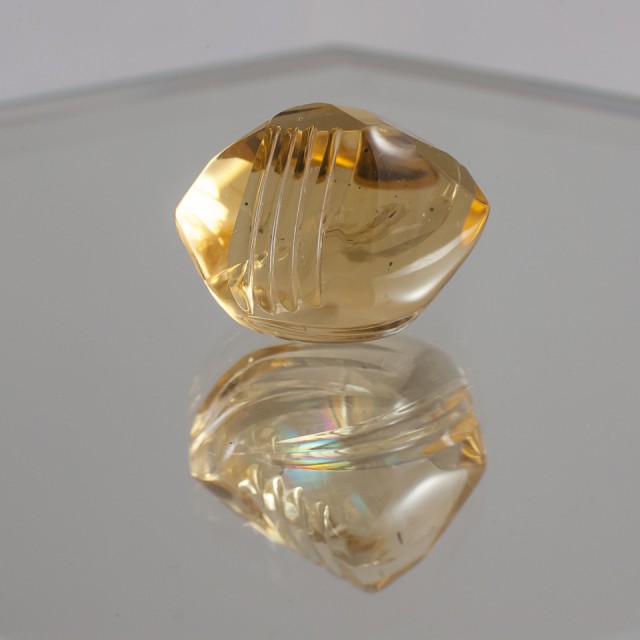
Scapolite Healing Properties
Most gems can be used as healing stones based on their color, composition, and spiritual energy. What are the healing properties of scapolite? This gem is believed to be a stone of purpose and achievement — helping you solve problems and become more self-resilient in every aspect of life.
Let’s discuss how this crystal can support your physical, emotional, and spiritual wellness.
Physical Healing
So what is scapolite used for in terms of physical wellbeing?
This gem is thought to help with glaucoma and cataracts. It’s also said to help in alleviating pain in the shoulders, neck, head, and upper chest.
Scapolite is also believed to help with high blood pressure, vein and artery issues, tension headaches, ear infections, and glandular disorders.
Like shungite, some say scapolite can help in absorbing and dispersing electromagnetic emissions from electrical devices.
Emotional Healing
In terms of emotional healing, scapolite gemstone meaning is associated with problem-solving and achievement. Crystal healers use scapolite to help infuse a sense of motivation and inspiration to work towards achieving goals. It’s also believed to help release burdening attachments to resolve past and present problems.
Ever feel overwhelmed? Scapolite may calm you down during stressful times. It’s believed to bring emotional balance, allowing for rational thinking during high-stress situations.
Next time you feel like your emotions are weighing you down, try meditating with a scapolite crystal to rid yourself of unnecessary worries and shift your mindset!
Chakra Healing
Some minerals are said to be chakra stones with spiritual energy that helps open, balance, and clear the chakras. Chakras are energy points along the center of the body. When in balance, healthy energy flows freely throughout keeping you in equilibrium. However, chakra blockages can manifest in physical and emotional ways.
Scapolite’s spiritual meaning of problem-solving carries over to its chakra healing abilities.
Common (yellow/golden) scapolite metaphysical properties are associated with the solar plexus chakra located at the upper belly of the diaphragm. It governs your personality, ego, and identity, as well as personal freedom, choice, and authenticity.

Types of Scapolite
As with most crystals, scapolite stone meanings and uses vary with color and composition. Other variations include:
Purple Scapolite (Petschite)
Petschite is the trade name for purple scapolite from Tanzania. It’s believed to resonate with the crown chakra, awaken psychic abilities, and bring more laughter into your life.
Gray Scapolite (Nuttalite)
Nuttalite is gray with blue or purple tints and slight chatoyancy (cat's eye effect). Like other gray crystals, it’s said to have grounding powers and is tied to the root chakra.
Blue Scapolite
Blue scapolite is said to stimulate the third eye and throat chakras. It’s believed to bring emotional balance and help you move forward through life.
Pink Scapolite
Pink scapolite is considered a powerful heart chakra cleanser. It’s believed to help you be more compassionate and receptive to forgiveness.
Rainbow Scapolite
Rainbow scapolite is an extremely rare stone containing iridescent inclusions. This gem is used for manifestation, attracting love, and inspiring loyalty.
So how do you identify a scapolite?
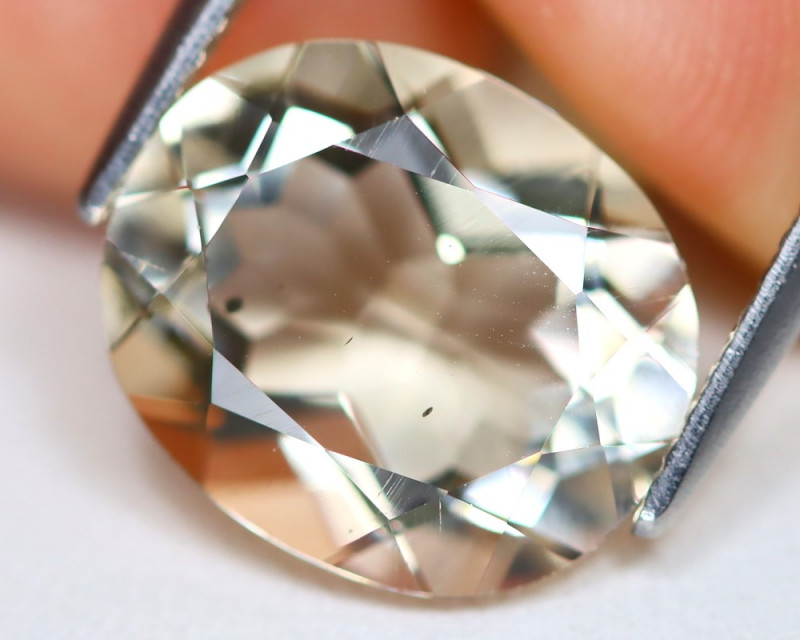
Scapolite Gemstone Properties
Assessing scapolite optical properties will tell you if it’s legitimate and valuable. Some of the factors that determine scapolite gemstone price are size, clarity, and strength of color.
Color
Scapolite’s most abundant hue is honey-yellow. It can also appear in varying shades of pink, purple, violet, blue, green, brown, and colorless.
Cat's eye scapolite commonly occurs in greenish, brown, or gray colors.
Bright, purple gems and specimens with high color intensity are considered to be the most valuable.
Cut
Scapolite is typically faceted into various shapes and styles like oval, cushion, rectangular, pear, and other fancy cuts.
When cut and polished, all scapolite exhibits a vitreous, glass-like luster.
Translucent specimens, like rainbow scapolite, are typically cut en cabochon to maximize their chatoyancy. Chatoyant scapolite must also be cut into a cabochon to properly display its “cat’s eye” effect.

Clarity
Scapolite usually has excellent transparency. Inclusions like hollow tubes, needles, and platelets are fairly common, especially in large gems.
Some translucent scapolite crystals have thin, parallel inclusions that cause chatoyancy. These gems are extremely rare and desirable.
Carat Weight
Scapolite is typically found in large sizes. In fact, most gems are over 6 carats in weight. Calibrated gemstones (cut to standard, jewelry-setting sizes) tend to fetch higher prices.
Treatments
Scapolite typically isn’t treated or enhanced, though some purple gems are heat-treated or irradiated.
Treated scapolite tends to fade with heat and light exposure. Natural purple specimens won’t fade in color.
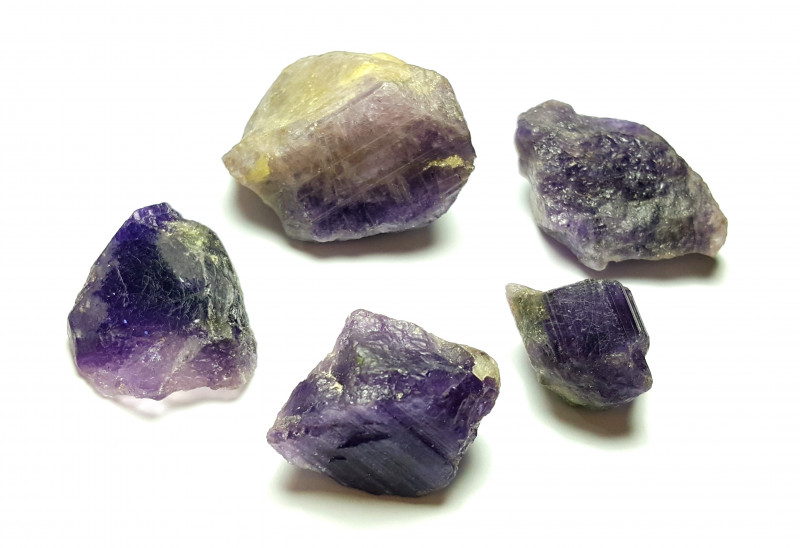
Scapolite Origins & Sources
Scapolite forms as an alteration mineral of feldspar grains in altered igneous rocks, like gabbro and basalt. It can appear in two entirely different and unrelated habits: large and stocky white, opaque crystals or prismatic, totally transparent, elongated crystals.
Scapolite is a complex mineral containing sodium, calcium, silicon, aluminum, oxygen, chlorine, carbon and sulfur. Specimens are easily attacked and damaged by weathering, making gem-quality scapolite rare.
Now, where is scapolite found?
Mining Locations
Despite its obscurity, scapolite can be found in a number of places across the world. Tanzania is believed to produce the highest quality specimens.
Other notable sources include:
Brazil, Burma (Myanmar)
Canada
Italy
Kenya
Madagascar
Mexico
Namibia
Norway
United States
Ready to shop? Let’s see what scapolite is worth!

Scapolite Price & Value
First, is scapolite expensive? It varies depending on aspects like color saturation, clarity, and sizing.
In terms of color, golden or yellow scapolite is most common and in turn, the most accessible. The average price starts at about $10 per carat. Next is purple scapolite, which costs around $20 per carat. Colorless scapolite costs about $25 per carat. Cat’s eye (or rainbow) scapolite can fetch prices as high as $50 per carat.
Natural purple or violet scapolite price varies greatly from irradiated stones. Untreated stones are rarer and have a delicate but purer purple hue. Untreated purple specimens exceed yellow in price, while irradiated purple ones do not.
How do you take care of your scapolite?

Scapolite Care and Maintenance
When caring for gemstones, remember each mineral has its own rules.
To clean your scapolite crystal, use mild soap, water, and a delicate cloth. Rinse well to remove all soapy residue and gently pat dry. Store your scapolite gems in a fabric-lined box where they’re not at risk of abrasion with other gems.
Take caution to avoid scapolite coming into contact with:
Sudden changes in temperature
Ultrasonic cleaners
Steamers
Wearing during exercise and harsh activities
Contact with harder substances

Rise to Every Challenge with Scapolite!
Looking for a crystal that’ll help you overcome every obstacle life throws your way? Harness this rare and beautiful gem’s problem-solving powers and take the first step towards achieving your dreams!
Ready to kiss your worries goodbye? Buy scapolite gemstones today!
Was this article helpful?
Ross Sedawie
- Written - 16th Apr 2022
- Edited - 1st Aug 2023
Comments

















